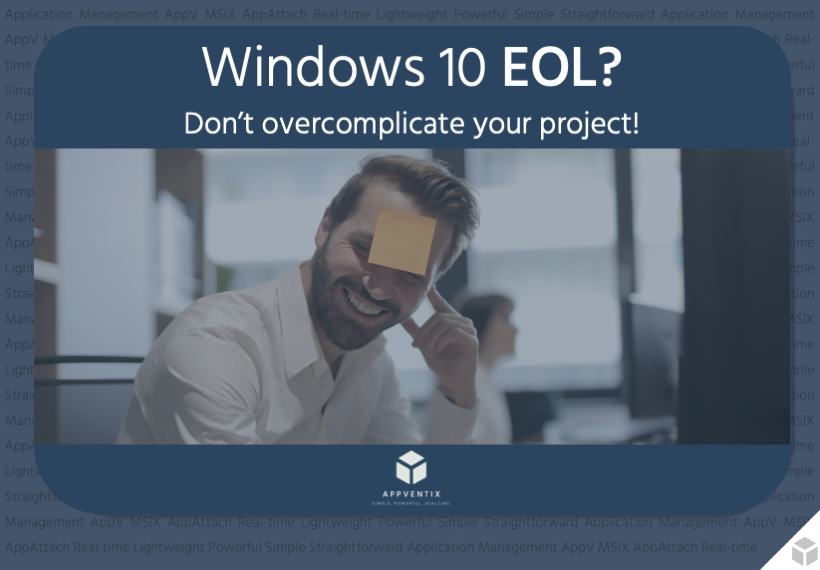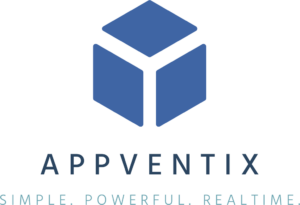With Windows 10 reaching end-of-life (EOL) in October 2025, IT teams worldwide are preparing for the inevitable migration to Windows 11. The focus should be clear: get your OS transition right—not waste time repackaging and testing every application in a rush.
“Here’s the truth: You don’t need to repackage all your apps.”
By lifting the EOL of App-V, you can continue using your existing App-V applications while executing your Windows 10 to Windows 11 migration smoothly. AppVentiX ensures your App-V applications run seamlessly on Windows 11, eliminating compatibility concerns and allowing IT teams to focus on a smooth OS transition. There’s no need to overhaul your application landscape at the same time. Instead, you can transition to MSIX at your own pace, minimizing risk, cost, and disruption.
Windows 10 EOL: The Real Challenge
Microsoft has announced that Windows 10 support will end on October 14, 2025. After this date, organizations will be left with two options:
- Upgrade to Windows 11 to stay supported, secure, and compliant.
- Pay for Extended Security Updates (ESU) to delay the inevitable (while spending unnecessary budget).
For enterprises, Windows 11 migration is non-negotiable. IT teams must ensure:
- Hardware compatibility – Upgrading systems that meet Windows 11’s stricter requirements.
-
Security compliance – Implementing modern security measures to stay compliant.
-
User training & adoption – Preparing employees for UI/UX changes.
-
Application compatibility – Ensuring business-critical apps continue working.
Where IT Projects Go Wrong
Many companies are making a costly mistake: They are trying to modernize their entire application estate at the same time as the Windows 11 migration.
This approach increases project risk exponentially because:
- Repackaging all applications into MSIX takes time. Not all apps convert smoothly, meaning delays and failures.
- Vendor lock-in becomes a risk. Changing application virtualization vendors can introduce complexity.
- Testing efforts double. Every repackaged app must be validated—on top of Windows 11 compatibility testing.
- Project scope balloons. The more dependencies IT teams introduce, the greater the chance of delays and failure.
This approach doesn’t scale—especially for enterprises with hundreds (or thousands) of applications.
The Smarter Approach: Lift the EOL of App-V
Instead of making two major IT shifts at once, a better strategy is to:
- Focus first on Windows 11 migration. Keep your existing App-V packages as they are to ensure a stable transition
- Continue using App-V applications. Even though App-V’s official EOL is 2026, you don’t need to abandon it overnight.
- Gradually transition to MSIX on your terms. Test and convert applications only when it makes sense—not under project pressure.
By taking this approach, you eliminate unnecessary complexity and avoid rushing into a high-risk repackaging project.
“Windows 11 should be your priority, not replacing App-V.”
Why AppVentiX is the Key to This Strategy
AppVentiX is designed to extend the life of your App-V applications, allowing you to continue running them on Windows 11 without modification.
Key Benefits of AppVentiX:
- No need for immediate repackaging – Your existing App-V packages run as-is, allowing a seamless OS transition.
- Supports gradual migration to MSIX – Convert applications only when necessary, instead of all at once.
- No reliance on outdated App-V infrastructure – AppVentiX eliminates dependency on App-V servers, making app management easier.
- Runs on modern Windows versions – Ensures App-V applications remain compatible with Windows 10, Windows 11, and beyond.
- Simplifies IT workloads – IT teams can focus on Windows 11 migration first, without application disruption.
This means you don’t have to worry about repackaging everything right away. Instead, you get a stable and supported path forward for your existing applications.
MSIX: The Future, But Not the Present
Microsoft has made it clear that MSIX is the future of application packaging. However, many organizations aren’t ready for full-scale adoption yet because:
- MSIX has compatibility gaps – Some legacy and complex applications don’t package well in MSIX.
- Application virtualization strategies vary – Not all IT environments are suited for a single format.
- Conversion is time-consuming – Repackaging large application estates adds project complexity.
With AppVentiX, you can extend App-V’s life while gradually modernizing your app packaging approach.
Bottom Line: Don’t Overcomplicate Your Project
By lifting the EOL of App-V, you can continue using the same application packages and App-V while gradually moving to MSIX. There’s no need to complicate your project by switching vendors and repackaging all your applications at once.
The future of application virtualization is a journey, not a sudden switch. Let AppVentiX help you take the right path forward.
Thank you for reading!
Check out our features page and our affordable pricing plans.

